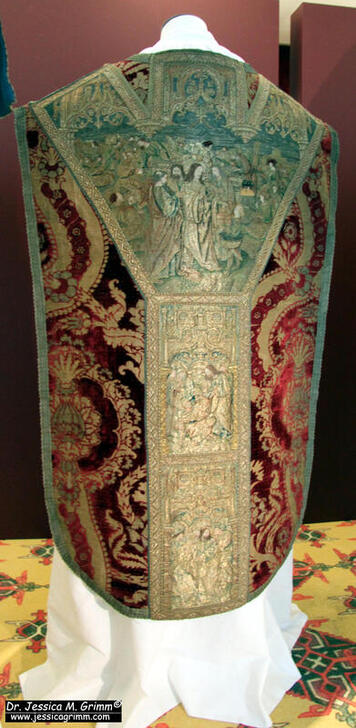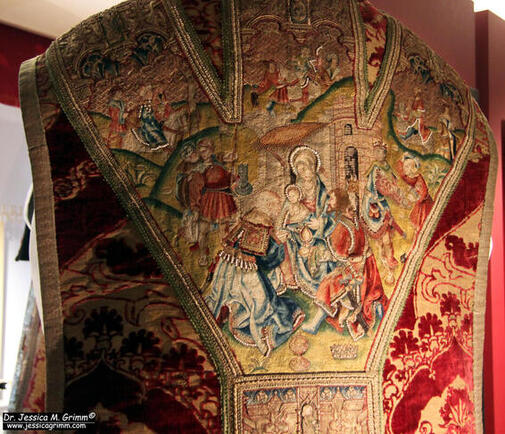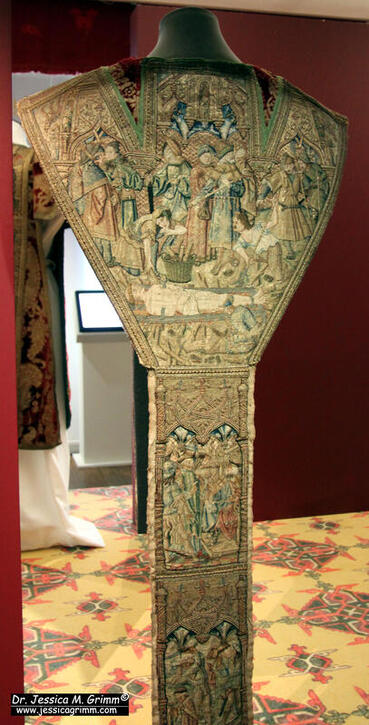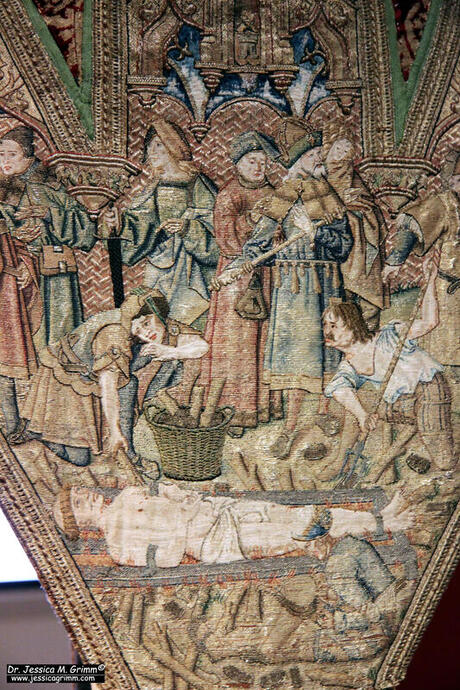|
For my research into late-medieval goldwork embroidery, I sometimes stumble upon interesting papers that were published a long time ago. They are usually written in Dutch, German or French and thus probably inaccessible to most of you. Today, I am going to introduce the story of embroidery master Peter Joosten from Amsterdam who accepted an order for an embroidered chasuble cross for the St. Walburgskerk (St Walburg Church) in Zutphen, the Netherlands. Not everything went as smoothly as the churchwardens had hoped as master Joosten turned out to be quite a character. Unfortunately, the actual embroidery has not survived. The story starts on the feast of Corpus Christi in AD 1544 when churchwarden Coenraad Slindewater and his brother receive master Joosten and his son. They discuss the possibility of master Joosten making a golden chasuble cross for a new chasuble for the Walburgskerk. The churchwarden pays for bed and board of master Joosten and his son at Evert Meijerijnck's house and for their travel expenses from Amsterdam to Zutphen. The church accounts also list expenses for the linen embroidery cloth and its shipping to Amsterdam and expenses for the design drawings. The payment for the later is made to glazier Johan Yseren. This is not unusual as embroidery patterns are more often made by glaziers (Van den Hoven van Genderen 2015) who needed to be able to paint in order to make leaded church windows. Master Joosten and his son travel to Zutphen again on the last day of February AD 1545 to sign the work contract. All expenses are paid for by the churchwarden. Master Joosten and his son even receive money for the loss of earnings whilst travelling. The contract stipulates that the churchwardens lend the embroidery pattern to master Joosten and will receive it back when the chasuble cross is finished. The embroidery should look better as both that of the cross that was shown to master Joosten by the churchwardens and better than the cross master Joosten had taken with him to show the churchwardens. Regarding the embroidery materials used: Master Joosten should only use the best materials and he should source the pearls himself (and being paid separately for them). Master Joosten demands a fee of 25 pont groit (probably the golden Carolus Guilder in use at the time). However, the churchwardens offer only 20 and the promise that the finished work will be valued upon completion. If to be found of a value more than 20 pont groit, master Joosten will receive a higher fee. It was apparently not easy for lay-people to judge the quality and value of goldwork embroidery. A stipulation like this in which the finished work is valued by a group of people is not unusual (for instance the work of Mabel of Saint Edmunds, embroideress for Henry III in London, was valued by "the better workers of the City of London" (Kent Lancaster, 1972)). The work contract also stipulates that master Joosten will finish the work as quickly as he can. He is forbidden to take on other work as long as the golden chasuble cross has not been finished. And whilst the churchwardens sign the contract with their full names, master Joosten uses a mark similar to that seen with stonemasons. It is thus likely that he was illiterate. On the 30th of July AD 1546, more than a year (!) after signing the work contract, master Joosten and his son travel to Zutphen again. They show the churchwardens part of the golden chasuble cross (the cross likely consists of several separate orphreys). Again, the churchwarden pays for travel, board and bed for both. And master Joosten goes back to Amsterdam and goes silent. It will take until the autumn of AD 1547 before a badly written letter reaches the churchwardens in which master Joosten asks for the patterns for the rest of the cross. He promises, that when he gets them in time, he will meet them at Easter to deliver the finished cross. However, Easter comes and goes and there is no chasuble cross. But the churchwardens do receive another letter in which master Joosten apologizes for the delay, but he has an abscess on his hand. He promises to meet them two weeks after Pentecost. This time, he sticks to his word. Fourteen days after Pentecost AD 1548, he brings them so many orphreys that they can make up half of the cross. The churchwardens pay him 5 pont groit for his work. And as always, all the other expenses for him and his son. Master Joosten does not speed up at all. Instead, he goes shopping. The Friday after the second Sunday of Lent in AD 1549 (!) he begs the churchwardens to pay for the oxen he has bought from Andries te Griffel. And guess what: the church wardens did pay for the oxen!
The churchwardens are finally having enough on the 25th of January AD 1550. They sent master Joosten a letter in which they threaten with the law. This helps. He and his daughter come to Zutphen and deliver the other half of the golden chasuble cross on the 14th of September AD 1550. The churchwardens, together with Johan Schymmelpenijncks (in which home the meeting takes place), Alphert van Till, Rense van Holthusen, the brother and brother-in-law of Coenraad Slindewater. These seven men appraise the work of master Joosten and decide that he shall get his 25 pont groit (minus part of the fee he had already been given in AD 1546). And again, they pay for everything for master Joosten and his daughter. In total, the chasuble cross has cost the churchwardens: I Cxxij gl. van xxviij st. br. xxij st. br. ende V placken. The author of the paper writes in a footnote that this amount "shall have been more than two-thousand guilders in today's money". According to the historical calculator on the website of the CBS, this would be the equivalent of € 25665 or $30480. No wonder the churchwardens were so lenient with master Joosten. They had invested thousands in AD 1546 and were afraid that it would all be for nougth if they pushed master Joosten over the edge. It also becomes clear that master Joosten probably violated the work contract as he must have taken on other work too. The above-mentioned fee would not have sustained him and his family over the six years it took to deliver the complete golden chasuble cross. But why he needed an oxen for his goldwork embroidery is anybody's guess :). Literature Hoven van Genderen, B. van den, 2015. Gewaden op papier. Kerkelijke textilia in Utrechtse archiefstukken. In: M. Leeflang & K. van Schooten (eds), Middeleeuwse borduurkunst uit de Nederlanden, p. 14-23. Kent Lancaster, R., 1972. Artists, Suppliers and Clerks: The Human Factors in the Art Patronage of King Henry III. Journal of the Warburg and Courtauld Institutes 35, p. 81–107. This title can be read online for free through JSTOR. Meinsma, K.O., 1901. Geschiedenis van een kazuifel, vervaardigd door Mr. Peter Joosten, borduurwerker te Amsterdam voor de St. Walburgskerk in Zutphen, Oud Holland 19 (2), p. 77-85. This title can be read online for free through JSTOR.
18 Comments
Claire de Pourtalès
8/3/2021 14:25:27
Love this story! It is so hard for us to really imagine what life was on day to day basis. Things seems so strange to us now! But one thing for sure is that embroidery was important back then!!! Thanks Jessica!
Reply
8/3/2021 16:20:43
Thank you, Claire! This story was just too good not to share.
Reply
Mabel
8/3/2021 14:27:54
Hoi Jessica,
Reply
8/3/2021 16:21:23
Dank je wel, Mabel! Het was gewoon te leuk om het niet te delen.
Reply
Truus Notermans
8/3/2021 15:15:36
Hallo Jessica,
Reply
8/3/2021 16:24:49
Nee, hoor Truus, zo lang duurt een kazuifelkruis borduren niet. Als hij het alleen deed zonder leerjongen en gezel, dan is een jaar heel realistisch. Had hij echter een atelier waarin in elk geval zijn zoon en dochter meewerkten, dan was dit klusje in een paar maanden te klaren. Uit andere bronnen kennen we de jaarproductie van bijvoorbeeld het atelier van Jacob van Malborch: 15 nieuwe paramenten en het opknappen van nog eens 20. Deze man maakte er dus duidelijk een potje van!
Reply
Debbie
8/3/2021 15:17:05
Hello Jessica , Thankyou for sharing this such an interesting story from the past . I love to see these photographs of such ancient and precious embroidery .It is just wonderful :)
Reply
Auck
8/3/2021 15:54:33
Hi Jessica,
Reply
8/3/2021 16:27:09
En dan te bedenken dat deze bedragen niet eens zo heel hoog zijn als loon. Nadat je alle materialen hebt afgetrokken (hij kreeg alleen het linnen en de parels), blijft er niet veel over.
Reply
9/3/2021 06:22:35
My idea exactly, Rachel! Anyway, he must have been a smooth talker :).
Reply
Kimberly McCoy
9/3/2021 01:10:26
Thank you for sharing, Jessika..So interesting!
Reply
Melissa Butterworth
9/3/2021 02:27:21
A really interesting story, with so much trust placed placed by the church wardens.
Reply
9/3/2021 06:26:03
Indeed, Melissa! And there was no penalty clause in the work contract, very unusual for that time.
Reply
Barbara
12/3/2021 12:58:29
Vielen Dank, Jessica, für das "Ausgraben" und Erzählen dieser interessanten Geschichte!
Reply
12/3/2021 13:01:42
Immer wieder gerne, Barbara! Es macht einfach zu viel Spaß :).
Reply
Your comment will be posted after it is approved.
Leave a Reply. |
Want to keep up with my embroidery adventures? Sign up for my weekly Newsletter to get notified of new blogs, courses and workshops!
Liked my blog? Please consider making a donation or becoming a Patron so that I can keep up the good work and my blog ad-free!
Categories
All
Archives
July 2024
|
Contact: info(at)jessicagrimm.com
Copyright Dr Jessica M. Grimm - Mandlweg 3, 82488 Ettal, Deutschland - +49(0)8822 2782219 (Monday, Tuesday, Friday & Saturday 9.00-17.00 CET)
Impressum - Legal Notice - Datenschutzerklärung - Privacy Policy - Webshop ABG - Widerrufsrecht - Disclaimer
Copyright Dr Jessica M. Grimm - Mandlweg 3, 82488 Ettal, Deutschland - +49(0)8822 2782219 (Monday, Tuesday, Friday & Saturday 9.00-17.00 CET)
Impressum - Legal Notice - Datenschutzerklärung - Privacy Policy - Webshop ABG - Widerrufsrecht - Disclaimer










 RSS Feed
RSS Feed